Synthetic fingerprints make plastic particles tiny security keys
Microscopic wrinkles squeezed onto the surface of tiny plastic particles could be used to create security keys that are impossible to duplicate.
The randomly-generated wrinkles are a lot like our own fingerprints, says Derek Breid at Saint Vincent College in Pennsylvania. Since each set is completely unique, the particles could be used to verify a person’s identity instead of them using a security card, or their own fingerprint. The particles could also be fixed to a priceless piece of art so people can be sure it’s the real deal.
Security keys made this way would be nearly impossible to clone, says Wook Park at Kyung Hee University in South Korea who developed the technique along with his colleagues.
Their method involves coating plastic particles with a thin sheet of silica, then soaking them in ethanol and leaving them to dry. As the particles dry, wrinkles form in the silica layer, creating a fingerprint-like structure.
Tiny irregularities in temperature, or the presence of dust or other particles influence the patterns to make them unique. “It’s a very chaotic process,” says Breid, which would make it almost impossible for anyone to accurately recreate a wrinkle pattern.
Creating them this way is much easier and cheaper than using a laser to etch in a specific maze of wrinkles. “It’s really useful not having expensive fabrication techniques,” he says.
Although the generation of the patterns is largely random, Park and his team developed a way of controlling where some of the wrinkles form. After they hardened parts of the plastic particles by exposing them to light, each hardened dot formed a “decision point” where the wrinkles either finish, bend or split.
 Now found on tiny plastic particles too Clouds Hill Imaging Ltd/Science Photo Library
Now found on tiny plastic particles too Clouds Hill Imaging Ltd/Science Photo Library
Being able to control at least some of these parameters could be handy for sharing messages. Manipulating a group of particles in the same way – exposing them to the same pattern of light, for example – could create a matched set with similar decision points. Although the overall fingerprint will still be random, a scanner reading the particle would be able to recognise the location of the decision points and thus know that a particular key, like a security card, belonged with a group of similar keys – that is, they open the same door, so they can be shared among a group who gets access to a message.
Jan Genzer at North Carolina State University is impressed with the results. “You can have pretty good control over the length and shape of the wrinkles,” he says.
Park and his team are now working on creating a less bulky scanner to inspect the patterns. They think a conductive scanner that reads electrical information from the surface might be more practical for use in security systems.
Journal reference: Science Advances, DOI: 10.1126/sciadv.1700071

